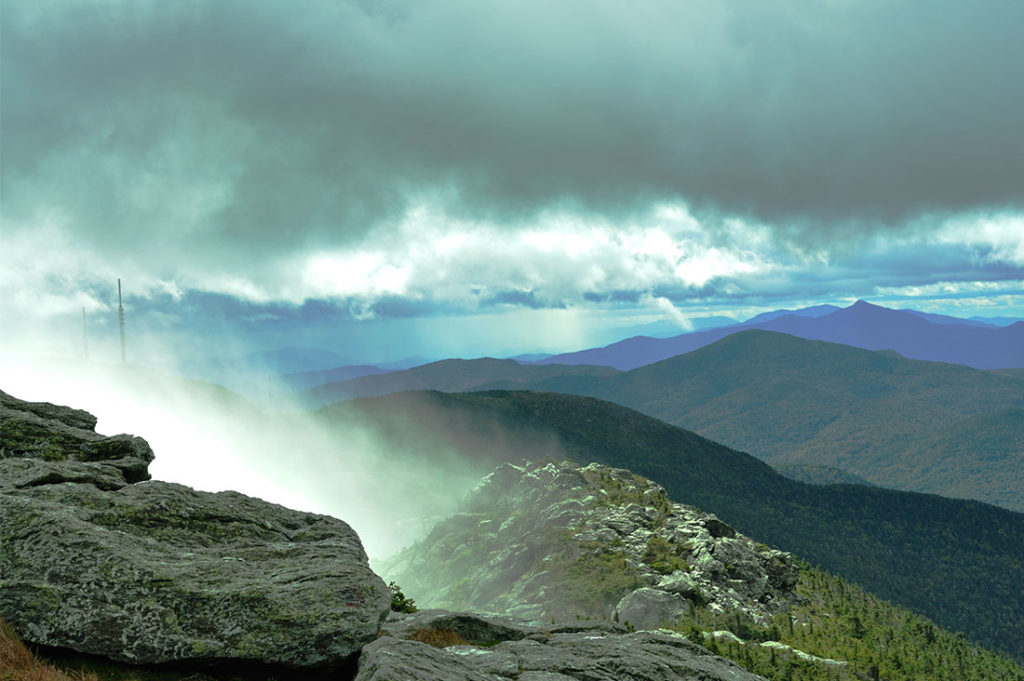
Outdoor activities are usually enjoyable, but of course they can be dangerous. Bad weather, iffy terrain, underlying health issues, and unpreparedness can all transform a great hike into a nightmare. Here are some preventative measures to avoid backcountry emergencies.
Every hiker is responsible for themselves in the backcountry. Familiarize yourself with and commit to the HikeSafe Responsibility Code before setting out.
Inform Someone of Your Whereabouts:
Ahead of your hike, let a family member or friend know your trip itinerary. You can also use satellite messengers or a GPS to ping your location at check-ins. Mark your progress in logbooks in case a search and rescue is necessary; if you sign with a trail name instead of your formal name, make sure your trusted family member/friend knows that information too.
The trail community can be supportive, but stranger danger is a real concern. If you ever feel unsafe around someone, listen to your intuition and move on. Let others know and alert GMC staff.
Anticipate Weather Emergencies:
Failing to check the weather is a common, and dangerous, hiker mistake. When hikers don’t check the weather forecast and the trail conditions, then they’re unlikely to have adequate gear or a contingency plan in case weather rolls in. Here are some seasonal conditions to anticipate and how to prepare:
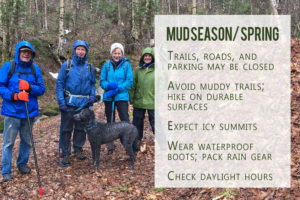
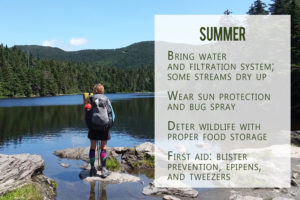
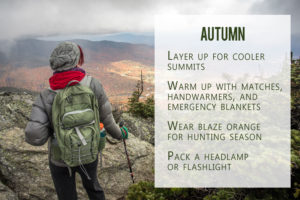
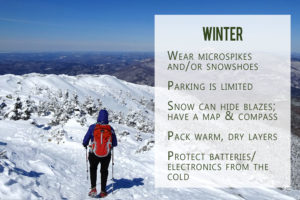
See our seasonal preparation cheat sheets. Click each image to enlarge.
- Falling temperatures. Through fall, winter, and into early June, you’ll see cooler temperatures and snow- or ice-blasted terrain; it can sometimes be warm and sunny at a trailhead, but cold and snowy as you climb. Know how to stay warm. Adequate layers and waterproof boots are necessities. Fire starters, waterproof matches, emergency blankets, and handwarmers can also aid you in emergencies.
Remember, the cold will also drain batteries and electronics faster; fuel canisters and water will also freeze. Store such items close to your body when possible or, when camping, in your sleeping bag. - Closures. Throughout winter and mud season, trails, parking areas, and roads may be closed or difficult to traverse. Research ahead of time to plan for added distance or to seek alternative trails.
- Precipitation. Rain may be common through spring and summer; check the forecast and pack rain gear and waterproof boots. Having dry socks on hand is crucial in all seasons, when sweat, mud, and rain may promote blistering. Take off and dry out your wet clothes when you can to prevent chafing and hypothermia. (Pro tip: a lunchtime siesta is the perfect time to take off your boots and dry out your wet socks and layers in the sun.)
Lastly, have Microspikes and/or snowshoes handy through winter and into early June, when peaks are still icy. - Sun exposure. Too much sun can cause emergencies as well. Prevent snow blindness with proper eye protection. In summer, protect yourself from sun sickness with proper layers, breaks in the shade, adequate hydration, and sunblock.
- Daylight hours. Daylight savings throws everyone off, but when you’re having a good time on the trail, it’s also easy to just lose track of your daylight hours. Pack a headlamp or flashlight; an emergency blanket or tent is helpful if you get caught out in the dark. Know ahead of time when the sun sets, and add a buffer for the daylight available below the canopy.
- Water sources. Be aware that through summer and drought periods, some water sources may be dry; through winter, they may be frozen. Pack adequate water (and drink it!) to avoid dehydration and help your body recover. And of course, it’s always best to filter water to avoid giardia and other illnesses.
- Navigation. Weather can disrupt effective navigation. Snow can camouflage trail blazes. Fog and rain can hinder your vision. Bring a map and compass and know how to use them. Store them in a dry bag or Ziploc. Always let someone know your plans ahead of travel, and write in logbooks to mark where you’ve been (like breadcrumbs) in case a search and rescue is necessary.
Avoid summits during thunderstorms and severe weather. Use bad-weather bypasses when necessary. And know when to turn around; the trail will be there another day.
Have an Appropriate First-Aid Kit:
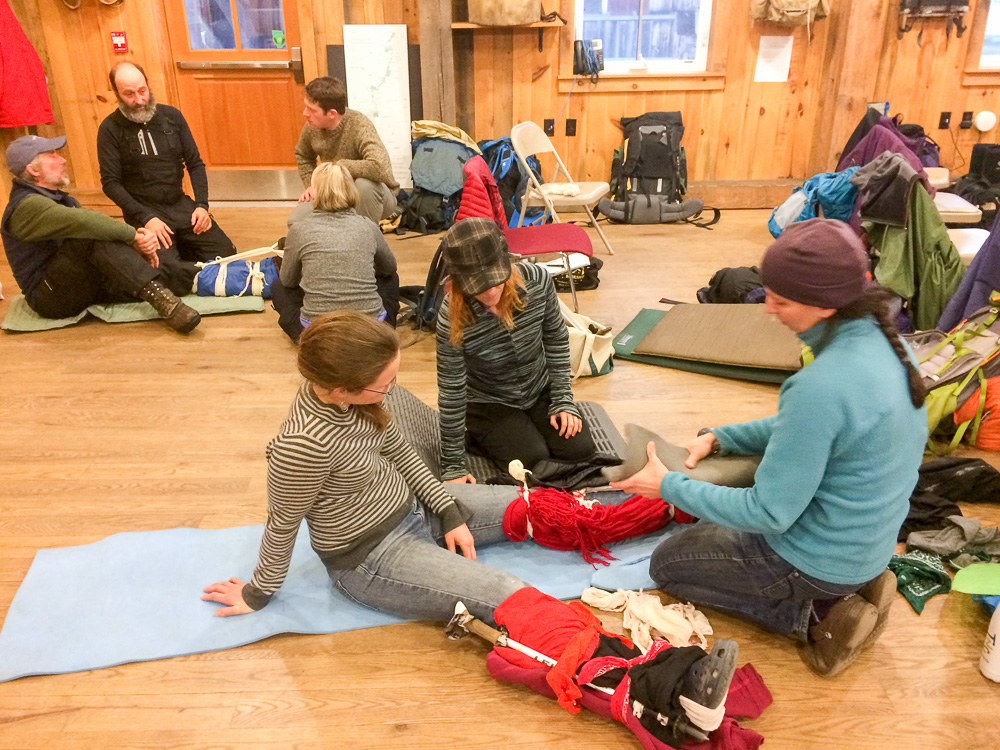
Proper first aid kits can be tricky. They add weight to your pack, but if faced with any emergencies, you’ll be glad you packed the right gear. Our rule of thumb is to pack items that have multiple uses. Use tweezers to remove ticks or clean out a wound. Athletic tape can become blister prevention or stabilize an ankle. Here are items we recommend to get you started:
Bandages:
- Sanitized gauze
- Athletic tape
- Ziplock bag
Tools:
- Tweezers
- Multitool (may include tweezers and scissors) or knife
- Stopwatch (helpful to track timing of symptoms or take a heart rate)
Medications & Ointments
- Personal medications (EpiPens, birth control, antibiotics)
- Painkillers (Ibuprofen, Acetaminophen, Aspirin; know when and when not to administer each)
- Antiseptic towelettes (although water and mild soap will do)
- Sunscreen
- Hand sanitizer or biodegradable soap
- Cortisol cream
Other:
- Wilderness First Aid Guide
- Small notebook and writing utensil
- Emergency heat-reflecting blanket
- Medical gloves/ latex gloves
- Tampons
When packing your first aid, it’s important to consider the group size, the length of trip, the activity, risk factors, and any special needs. More info here.
Keep an index card or medical ID tag outlining your name/age/emergency contact and any pertinent medical information (such as underlying health conditions, medications, and allergies) in case someone needs to assist you; in a group setting, the trip leader should be aware of others’ health conditions.
Additionally, it’s important to note that you never want to administer treatment if you haven’t had proper training. For example, most of us will not be administering stitches in the backcountry. Take a wilderness first aid course for more guidance (and peace of mind).
Filter Water from Backcountry Sources:
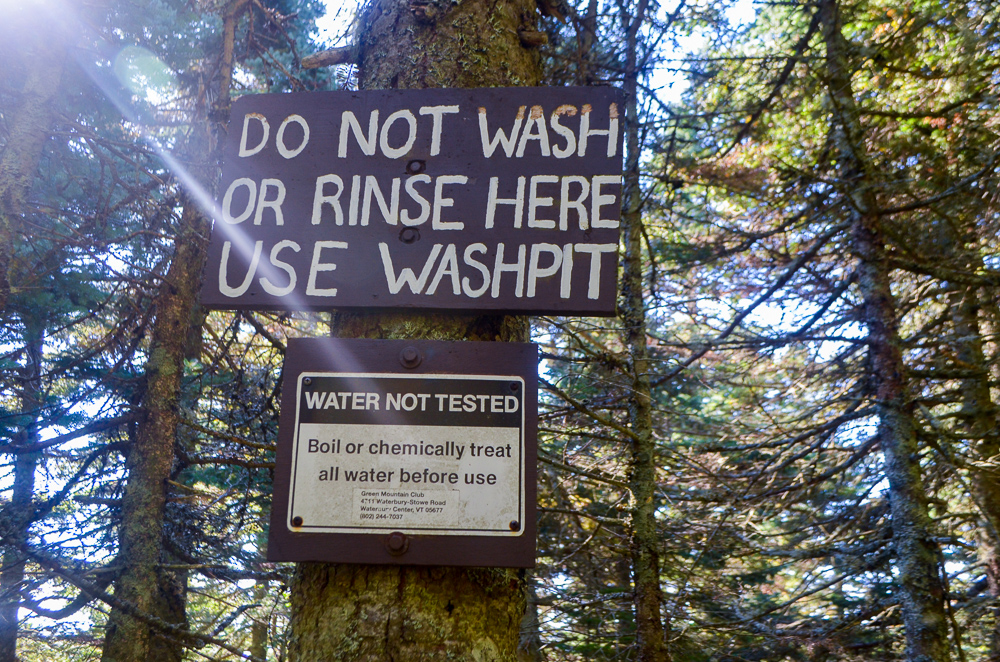
Always treat your water in the backcountry—it’s your best bet against gastrointestinal illness. And with the various technologies, there’s no excuse not to find one that works for you. Learn more here about boiling water, water filtration, chemical treatments, and UV purifiers.
Respect Wildlife:

While bears and moose may hog your attention, bear attacks are very rare and moose sightings even rarer. Read: what to do if a bear attacks and how to prevent interactions.
The real buggers to look for are the ones you can hardly see. Ticks thrive in all seasons; wear bug spray, tuck your pants into your socks, and bring tweezers for insect-removal. Never try to suffocate or burn a tick off you; this can cause them to regurgitate harmful bacteria – like the one that causes Lyme Disease – into your body. When you leave the woods, do a tick check and take a hot shower to spot and remove these arachnids.
Additionally, know when mosquitos, black flies, and Hymenoptera (wasps, hornets, bees, and ants) are active. If you have seasonal allergies, carry antihistamines or an EpiPen to prevent emergencies. Most wildlife is active during the warming months, early spring to late fall.
Poison ivy and poison sumac are both present in Vermont. Know how to identify, avoid, and treat potential reactions.
Know that 9-1-1 isn’t always an option for emergencies in the backcountry. Providing help can be time- and resource-consuming, and puts others at risk. Know how to get yourself out of the woods safely, and when to turn around. Never push yourself or others into a hazardous situation. The trail will be there tomorrow, so prioritize your safety so you can later enjoy it.
Have questions? Reach out to a medical provider or responder. Contact our Visitor Center for more on trail conditions and trip prep.



















At Trailheads there are ‘Sign In’ sheets. Name, emergency phone #, health issues. Sign in and most important remember to sign out or we will be out searching for you and you can pay the fine.
Yes, the trailhead registers a re a great tool! However, in Vermont there is absolutely no cost or fine associated with any search and rescue needs.